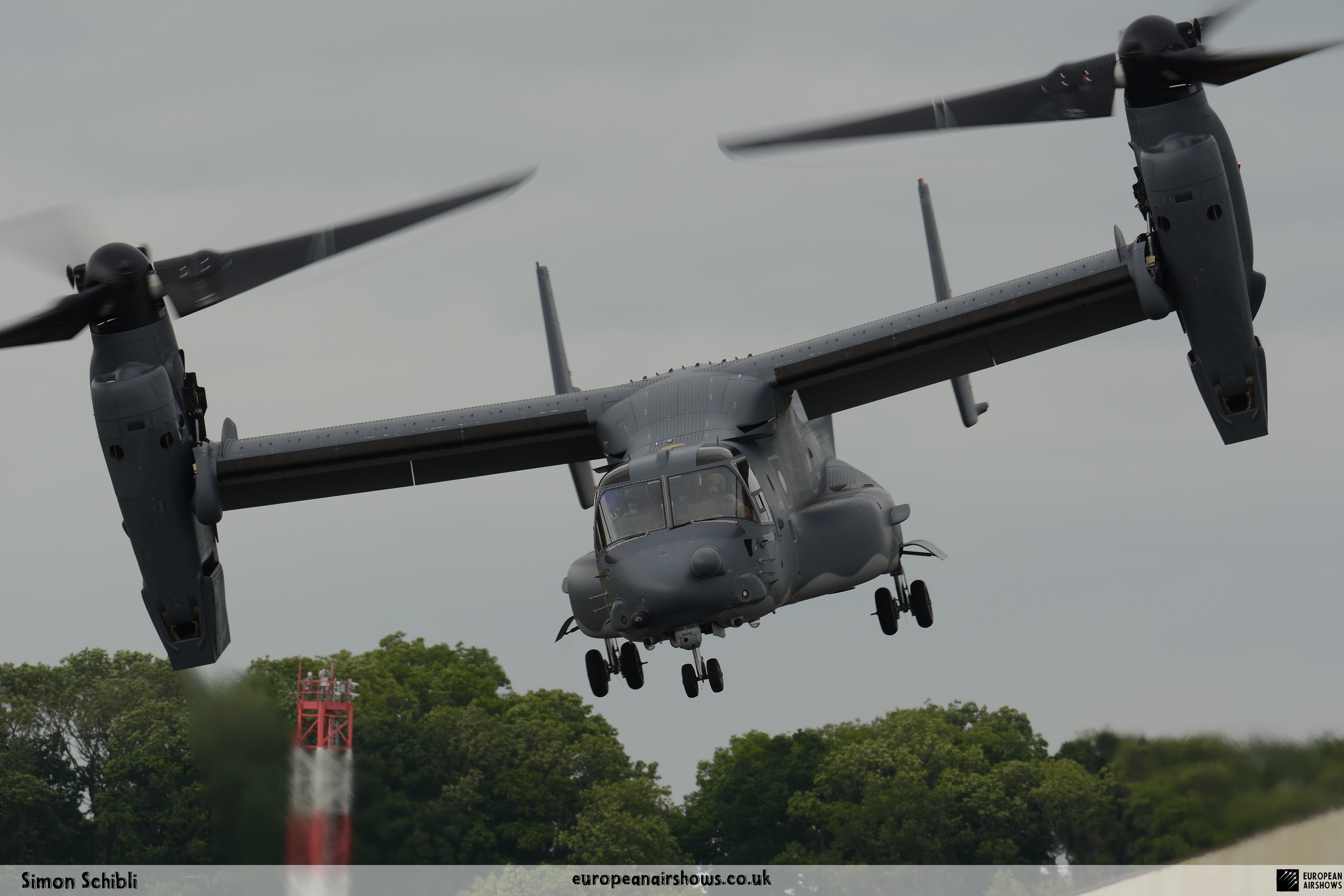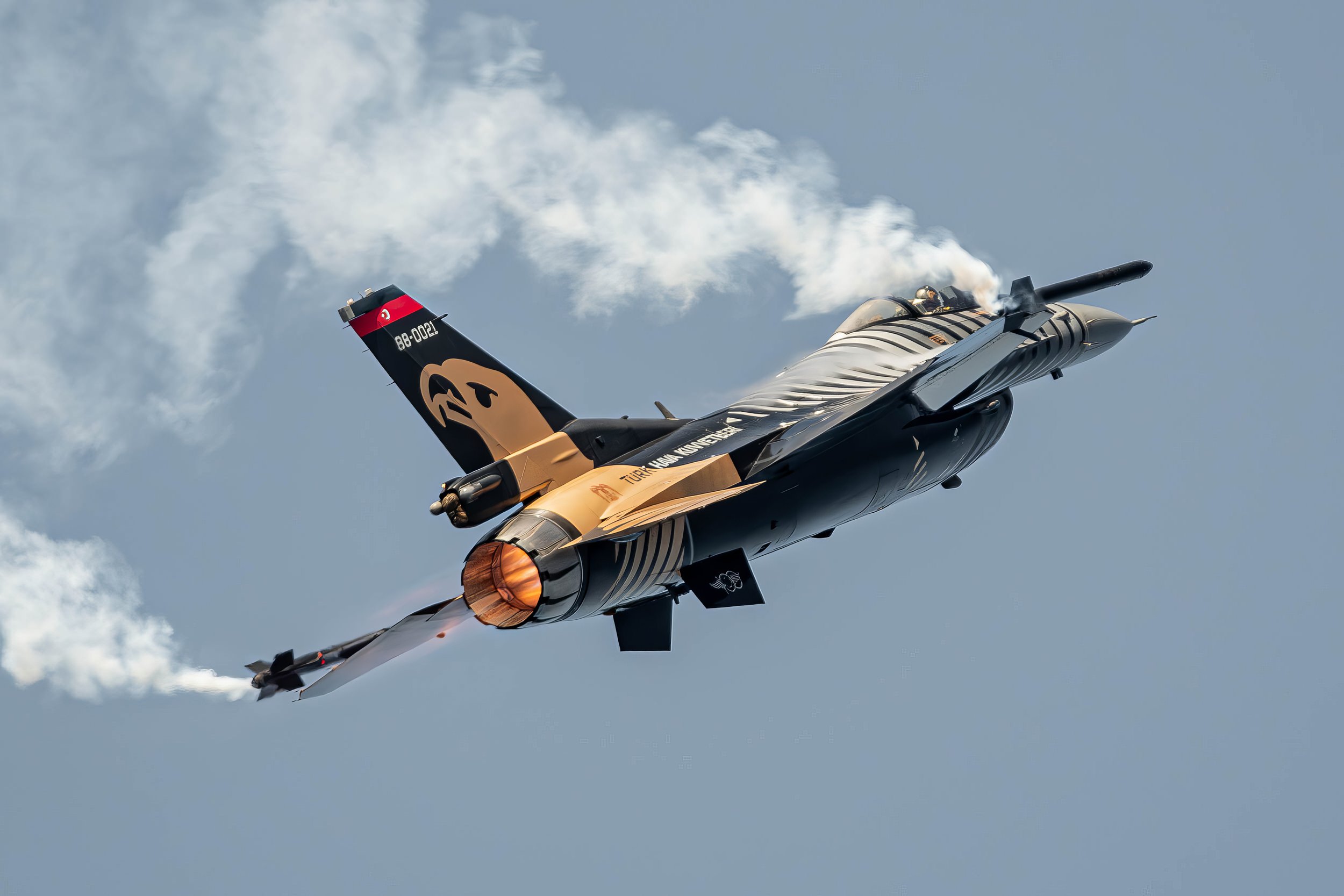USAF CV-22 Osprey Demo
Country
United States
Aircraft
CV-22B OspreyA
Base
RAF Mildenhall
Bell Boeing CV-22B Osprey
The CV-22B is the U.S. Air Force variant of the V-22 for the U.S. Special Operations Command. It conducts long-range special operations missions and is equipped with extra wing fuel tanks, AN/APQ-186 terrain-following radar, and other equipment such as the AN/ALQ-211, and AN/AAQ-24 Nemesis Directional Infrared Counter Measures. The fuel capacity is increased by 588 gallons with two inboard wing tanks; three auxiliary tanks (200 or 430 gal) can also be added to the cabin. The CV-22 replaced the MH-53 Pave Low.
The Bell Boeing V-22 Osprey is an American multi-mission, tiltrotor military aircraft with both vertical takeoff and landing (VTOL) and short takeoff and landing (STOL) capabilities. It is designed to combine the functionality of a conventional helicopter with the long-range, high-speed cruise performance of a turboprop aircraft.
The failure of Operation Eagle Claw during the Iran hostage crisis in 1980 underscored the requirement for a long-range, high-speed, vertical-takeoff aircraft for the United States Department of Defense (DoD). In response, the Joint-service Vertical take-off/landing Experimental (JVX) aircraft program started in 1981. A partnership between Bell Helicopter and Boeing Helicopters was awarded a development contract in 1983 for the V-22 tiltrotor aircraft. The Bell Boeing team jointly produce the aircraft. The V-22 first flew in 1989 and began flight testing and design alterations; the complexity and difficulties of being the first tiltrotor for military service led to many years of development.
The United States Marine Corps (USMC) began crew training for the MV-22B Osprey in 2000 and fielded it in 2007; it supplemented and then replaced their Boeing Vertol CH-46 Sea Knights. The U.S. Air Force (USAF) fielded their version of the tiltrotor, CV-22B, in 2009. Since entering service with the U.S. Marine Corps and Air Force, the Osprey has been deployed in transportation and medevac operations over Iraq, Afghanistan, Libya, and Kuwait.
The Osprey is the world's first production tiltrotor aircraft, with one three-bladed proprotor, turboprop engine, and transmission nacelle mounted on each wingtip. It is classified as a powered lift aircraft by the Federal Aviation Administration. For takeoff and landing, it typically operates as a helicopter with the nacelles vertical and rotors horizontal. Once airborne, the nacelles rotate forward 90° in as little as 12 seconds for horizontal flight, converting the V-22 to a more fuel-efficient, higher speed turboprop aircraft. STOL rolling-takeoff and landing capability is achieved by having the nacelles tilted forward up to 45°. Other orientations are possible.
Composite materials make up 43% of the airframe, and the proprotor blades also use composites. For storage, the V-22's rotors fold in 90 seconds and its wing rotates to align, front-to-back, with the fuselage. Because of the requirement for folding rotors, their 11.6 m diameter is 1.5 m less than optimal for vertical takeoff, resulting in high disk loading. Most missions use fixed wing flight 75% or more of the time, reducing wear and tear and operational costs. This fixed-wing flight is higher than typical helicopter missions allowing longer range line-of-sight communications for improved command and control.
Exhaust heat from the V-22's engines can potentially damage ships' flight decks and coatings. NAVAIR devised a temporary fix of portable heat shields placed under the engines and determined that a long-term solution would require redesigning decks with heat resistant coating, passive thermal barriers, and ship structure changes. Similar changes are required for F-35B operations. In 2009, DARPA requested solutions for installing robust flight deck cooling. A heat-resistant anti-skid metal spray named Thermion has been tested on USS Wasp.
The V-22's two Rolls-Royce AE 1107C engines are connected by drive shafts to a common central gearbox so that one engine can power both proprotors if an engine failure occurs. Either engine can power both proprotors through the wing driveshaft. However, the V-22 is generally not capable of hovering on one engine. If a proprotor gearbox fails, that proprotor cannot be feathered, and both engines must be stopped before an emergency landing. The autorotation characteristics are poor because of the rotors' low inertia.
In September 2013, Rolls-Royce announced that it had increased the AE-1107C engine's power by 17% via the adoption of a new Block 3 turbine, increased fuel valve flow capacity, and software updates; it should also improve reliability in high-altitude, high-heat conditions and boost maximum payload limitations from 6,000 to 8,000 shp. A Block 4 upgrade is reportedly being examined, which may increase power by up to 26%, producing close to 10,000 shp, and improve fuel consumption.
The V-22 has a maximum rotor downwash speed of over 150 km/h, more than the 119 km/h lower limit of a hurricane. The rotor wash usually prevents the starboard door's usage in hover; the rear ramp is used for rappelling and hoisting instead. The V-22 loses 10% of its vertical lift over a tilt-wing design when operating in helicopter mode because of the wings' airflow resistance, while the tiltrotor design has better short takeoff and landing performance. V-22s must keep at least 7.6 m of vertical separation between each other to avoid each other's rotor wake, which causes turbulence and potentially control loss.
The V-22 is equipped with a glass cockpit, which incorporates four multi-function displays (MFDs, compatible with night-vision goggles) and one shared central display unit, to display various images including digit maps, imagery from the Turreted forward-looking infrared system primary flight instruments, navigation (TACAN, VOR, ILS, GPS, INS), and system status. The flight director panel of the cockpit management system allows for fully coupled (autopilot) functions that take the aircraft from forwarding flight into a 15 m hover with no pilot interaction other than programming the system. The fuselage is not pressurized, and personnel must wear onboard oxygen masks above 10,000 feet.
The V-22 has triple-redundant fly-by-wire flight control systems; these have computerized damage control to automatically isolate damaged areas. With the nacelles pointing straight up in conversion mode at 90°, the flight computers command it to fly like a helicopter, cyclic forces being applied to a conventional swashplate at the rotor hub. With the nacelles in aeroplane mode (0°) the flaperons, rudder, and elevator fly similar to an aeroplane. This is a gradual transition, occurring over the nacelles' rotation range; the lower the nacelles, the greater effect of the aeroplane-mode control surfaces. The nacelles can rotate past vertical to 97.5° for rearward flight. The V-22 can use the "80 Jump" orientation with the nacelles at 80° for takeoff to quickly achieve high altitude and speed. The controls automate to the extent that they can hover in the low wind without hands on the controls. Some V-22 pilots claim that former fixed-wing pilots may be preferable over helicopter users as they are not trained to constantly adjust the controls in hover.
The V-22 can be armed with one 7.62×51mm NATO (.308 in caliber) M240 machine gun or .50 in caliber (12.7 mm) M2 machine gun on the rear loading ramp. A 12.7 mm (.50 in) GAU-19 three-barrel Gatling gun mounted below the nose was studied. BAE Systems developed a belly-mounted, remotely operated gun turret system, the Interim Defense Weapon System (IDWS); it is remotely operated by a gunner, targets are acquired via a separate pod using colour television and forward-looking infrared imagery. The IDWS was installed on half of the V-22s deployed to Afghanistan in 2009; it found limited use because of its 360 kg weight and restrictive rules of engagement.
There were 32 IDWSs available to the USMC in June 2012; V-22s often flew without it as the added weight reduced cargo capacity. The V-22's speed allows it to outrun conventional support helicopters, thus a self-defence capability was required on long-range independent operations. The infrared gun camera proved useful for reconnaissance and surveillance. Other weapons were studied to provide all-quadrant fire, including nose guns, door guns, and non-lethal countermeasures to work with the current ramp-mounted machine gun and the IDWS.
In 2014, the USMC studied new weapons with "all-axis, stand-off, and precision capabilities", akin to the AGM-114 Hellfire, AGM-176 Griffin, Joint Air-to-Ground Missile, and GBU-53/B SDB II. In November 2014, Bell Boeing conducted self-funded weapons tests, equipping a V-22 with a pylon on the front fuselage and replacing the AN/AAQ-27A EO camera with an L-3 Wescam MX-15 sensor/laser designator. 26 unguided Hydra 70 rockets, two guided APKWS rockets, and two Griffin B missiles were fired over five flights. The USMC and USAF sought a traversable nose-mounted weapon connected to a helmet-mounted sight; recoil complicated integrating a forward-facing gun. A pylon could carry 140 kg of munitions. However, by 2019, the USMC opted for IDWS upgrades over adopting new weapons.
Boeing is developing a roll-on/roll-off aerial refuelling kit, which would give the V-22 the ability to refuel other aircraft. Having an aerial refuelling capability that can be based on Wasp-class amphibious assault ships would increase the F-35B's strike power, removing the reliance on refuelling assets solely based on large Nimitz-class aircraft carriers or land bases. The roll-on/roll-off kit can also be applicable to intelligence, surveillance and reconnaissance (ISR) function. Boeing funded a non-functional demonstration on a VMX-22 aircraft; a prototype kit was successfully tested with a F/A-18 on 5 September 2013.
The high-speed version of the hose/drogue refuelling system can be deployed at 343 km/h and function at up to 460 km/h. A mix of tanks and a roll-on/roll-off bladder house up to 5,400 kg of fuel. The ramp must open to extend the hose, then raised once extended. It can refuel rotorcraft, needing a separate drogue used specifically by helicopters and a converted nacelle. Many USMC ground vehicles can run on aviation fuel, a refuelling V-22 could service these. In late 2014, it was stated that V-22 tankers could be in use by 2017, but contract delays pushed IOC to late 2019. As part of a 26 May 2016 contract award to Boeing, Cobham was contracted to adapt their FR-300 hose drum unit as used by the KC-130 in October 2016. While the Navy has not declared its interest in the capability, it could be leveraged later on.
| Back to Top |













| Back to Top |

































